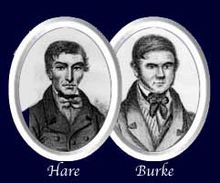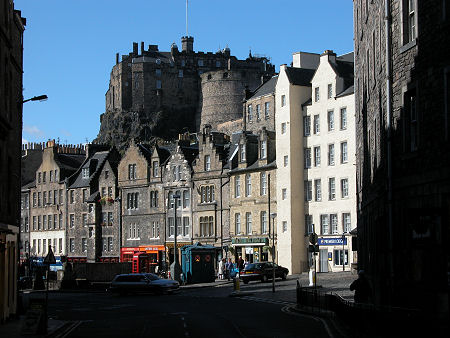| This Week’s Topic… | |

Best viewed in
|
Burke and Hare William Burke lived from 1792 to 28 January 1829. His partner-in-crime, William Hare, lived from (probably) 1792 to 1859. The two are almost always paired together, being known simply as Burke and Hare. They achieved their infamy in an age when it was common for body-snatchers or "resurrectionists" to steal freshly-buried bodies from graveyards to sell them for dissection or anatomy lectures in medical schools. Burke and Hare took this to its, for them, logical conclusion: cutting out the tiresome business of digging up corpses by murdering carefully selected victims so their bodies could be sold. William Hare came from the northern part of Ireland, and he emigrated to Scotland to work as a Navy (navigational engineer) on the construction of the Union Canal. Moving to Edinburgh, he became the common-law husband of Maggie Laird, and the two established a boarding house in a squalid tenement in Tanners Close off Edinburgh's West Port.
William Burke was born in southern Ireland. In about 1817, after trying various ways to earn a living, he abandoned a wife and two children and immigrated to Scotland. Here he took up employment, first as a Navy on the Union Canal, where he probably first met Hare, and later as a laborer, weaver, baker and finally a cobbler. By 1827 he was living with his mistress, Helen MacDougal, in William Hare and Maggie Laird's lodging house. In the early 1800s there was only a very limited legitimate supply of cadavers for medical schools to use in the study and teaching of anatomy. At a time when medical schools were rapidly expanding, demand rose quickly, and a widespread industry developed, disinterring fresh corpses from graveyards for sale to medical schools who rarely if ever asked any questions about their origin. These body-snatchers or resurrectionists became widely feared and hated, and many churchyards still contain watch-houses from which fresh graves were guarded, or mort-safes in which fresh corpses were locked until they had decayed beyond the point body-snatchers would be interested, before being buried. Burke and Hare's involvement began in November 1827, when an old army pensioner called Donald died in the Tanners Close lodging house, owing Hare and Laird £4 in unpaid rent. Burke and Hare removed the body from its coffin and sold it to a private anatomy school run by the eminent Edinburgh anatomist, Robert Knox, for £7. Having found a lucrative market, Burke and Hare now considered ways of supplying it. Conveniently, another tenant of the lodging house, Joseph the Miller, was sick. Rather than wait for him to die, Burke and Hare plied Joseph the Miller with whisky, then suffocated him before selling his corpse to Knox. This exhausted the ready supply of residents of the lodging house, so in February 1828 Burke and Hare offered accommodation to Abigail Simpson, before getting her drunk and smothering her, then carting her off to Knox's anatomy school. Because her corpse was so fresh, Knox paid Burke and Hare £15. Another tenant of the lodging house followed; then a woman invited into the house by Maggie Laird. Next, Burke brought two prostitutes to the lodging house, Mary Patterson and Janet Brown. Brown left after an argument erupted between Helen MacDougal and William Burke, and when she returned, she was told that Patterson had left with Burke. Next morning some of Knox's medical students recognized Mary Patterson on the dissecting table, presumably because they had used her services. The grisly spree continued. Further victims included a beggar woman called Effie, who earned them £10; a woman who Burke had "saved" from the police by vouching for her character; an old woman and a deaf boy who they sold for £8 each; Burke's acquaintance Mrs. Ostler; and Helen MacDougal's relative Ann MacDougal. They were followed by the elderly prostitute Mary Haldane, and then her daughter Peggy Haldane, when she tried to find out what had happened to her mother. Mary Haldane was well known in the area and (finally) suspicions began to be voiced about Burke and Hare. Their next victim was even better known, a young man known as Daft Jamie. Several of Knox's students recognized him. Knox denied that the corpse was Daft Jamie, but unusually commenced the dissection on this face. In early November 1828, Burke and Hare killed their 17th and final victim, Mary Docherty. Her body was discovered hidden under a bed in the lodging house by two lodgers, James and Ann Gray. Helen MacDougal tried to prevent them going to the police by offering to pay them £10 per week: they reported what they had found anyway. Burke and Hare removed (and sold) Mary Docherty's body before the police arrived, but told inconsistent stories about her when arrested: and then Docherty's body was found at Knox's anatomy school. The case was reported in the Edinburgh papers on 6 November 1828. The prostitute, Janet Brown, went to the police, and was able to identify clothing found at the lodging house as belonging to Mary Patterson. Despite all this, the case against Burke and Hare was not watertight, so Hare was offered immunity from prosecution if he confessed and agreed to testify against Burke (who had, according to Hare, committed the actual murders). His testimony led to Burke's execution on 28 January 1829. Burke's body was then made available for dissection, and some of his skin was allegedly used to bind a book now on view in the museum of the Royal College of Surgeons of Edinburgh. Hare was released, and is said to have been blinded during an attack by a lynch-mob, later dying as a beggar in London. Helen MacDougal was released, almost lynched, and fled to Australia, where she remained. Maggie Laird was also released, and fled to Ireland. Robert Knox was not prosecuted, despite a public outcry against him. Unable to continue working in Edinburgh, he moved to practice medicine in London. More widely, Burke and Hare's activities resulted in the passing of the Anatomy Act 1832, which expanded the legal supply of medical cadavers and eliminated the incentive that had led them to murder 17 people. |

